Neurofeedback Effects on EEG Connectivity among Children with Reading Disorders: I. Coherence
Abstract
1. Introduction
1.1. EEG Characteristics in Children with RD
1.2. Neurofeedback
1.3. NFB Studies Using Theta/Alpha Reduction Protocol
2. Materials and Methods
2.1. Design
2.2. Participants
2.2.1. Children with RD and Delayed EEG Maturation
2.2.2. Children with Typical Development
2.3. EEG Recording and Analysis
2.4. Z Values for the Theta/Alpha Ratio
2.5. Treatments
2.5.1. NFB Treatment
2.5.2. Sham NFB Treatment
2.6. Posttreatment Analysis
2.7. Coherence Analysis
2.8. Statistical Analysis
2.8.1. RD Group vs. TD Group
2.8.2. NFB vs. Sham Groups Regarding Pre-Post Treatment Changes in Children with RDs
2.8.3. Pre-Post Treatment Comparisons for Each Group (NFB or Sham)
3. Results
3.1. Comparison between Children with RDs and Children with Typical Development
3.1.1. Intrahemispheric Coherence
3.1.2. Interhemispheric Coherence
3.2. Comparison between NF and Sham Groups with Respect to Pre-Post Treatment Changes
3.2.1. Treatment-Induced Learning
3.2.2. Behavioral Outcomes
3.2.3. Functional Connectivity Changes: Intrahemispheric Coherence
3.2.4. Functional Connectivity Changes: Interhemispheric Coherence (Homologous Pairs)
4. Discussion
4.1. Children with RDs vs. Children with TD
4.2. NFB Effects on Coherence in Children with RDs
Author Contributions
Funding
Institutional Review Board Statement
Informed Consent Statement
Data Availability Statement
Acknowledgments
Conflicts of Interest
References
- Galaburda, A.; Camposano, S. Dislexia Evolutiva: Un Modelo Exitoso de Neuropsicología Genética. Rev. Chil. Neuropsicol. 2006, 1, 9–14. [Google Scholar]
- Puente, A.; Jiménez, V.; Ardila, A. Anormalidades Cerebrales En Sujetos Disléxicos. Rev. Latinoam. Psicol. 2009, 41, 27–45. [Google Scholar]
- Žarić, G.; Correia, J.M.; González, G.F.; Tijms, J.; van der Molen, M.W.; Blomert, L.; Bonte, M. Altered patterns of directed connectivity within the reading network of dyslexic children and their relation to reading dysfluency. Dev. Cogn. Neurosci. 2017, 23, 1–13. [Google Scholar] [CrossRef] [PubMed]
- Cutting, L.E.; Clements-Stephens, A.; Pugh, K.R.; Burns, S.; Cao, A.; Pekar, J.J.; Davis, N.; Rimrodt, S.L.; Bailey, S.; Hoeft, F.; et al. Not All Reading Disabilities Are Dyslexia: Distinct Neurobiology of Specific Comprehension Deficits. Brain Connect. 2013, 3, 199–211. [Google Scholar] [CrossRef] [PubMed]
- Gabrieli, J.D.E. Dyslexia: A New Synergy Between Education and Cognitive Neuroscience. Science 2009, 325, 280–283. [Google Scholar] [CrossRef]
- Démonet, J.-F.; Taylor, M.J.; Chaix, Y. Developmental dyslexia. Lancet 2004, 363, 1451–1460. [Google Scholar] [CrossRef]
- American Psychiatric Association. Diagnostic and Statistical Manual of Mental Disorders; American Psychiatric Association: Philadelphia, PA, USA, 2013. [Google Scholar] [CrossRef]
- Dhar, M.; Been, P.H.; Minderaa, R.B.; Althaus, M. Reduced interhemispheric coherence in dyslexic adults. Cortex 2010, 46, 794–798. [Google Scholar] [CrossRef]
- Galaburda, A.M.; Sherman, G.F.; Rosen, G.D.; Aboitiz, F.; Geschwind, N. Developmental dyslexia: Four consecutive patients with cortical anomalies. Ann. Neurol. 1985, 18, 222–233. [Google Scholar] [CrossRef]
- Casanova, M.F.; El-Baz, A.; Giedd, J.; Rumsey, J.M.; Switala, A. Increased White Matter Gyral Depth in Dyslexia: Implications for Corticocortical Connectivity. J. Autism Dev. Disord. 2010, 40, 21–29. [Google Scholar] [CrossRef]
- Williams, V.J.; Juranek, J.; Cirino, P.; Fletcher, J.M. Cortical Thickness and Local Gyrification in Children with Developmental Dyslexia. Cereb. Cortex 2018, 28, 963–973. [Google Scholar] [CrossRef]
- Martin, A.; Schurz, M.; Kronbichler, M.; Richlan, F. Reading in the brain of children and adults: A meta-analysis of 40 functional magnetic resonance imaging studies. Hum. Brain Mapp. 2015, 36, 1963–1981. [Google Scholar] [CrossRef] [PubMed]
- Richlan, F.; Kronbichler, M.; Wimmer, H. Functional abnormalities in the dyslexic brain: A quantitative meta-analysis of neuroimaging studies. Hum. Brain Mapp. 2009, 30, 3299–3308. [Google Scholar] [CrossRef] [PubMed]
- Richlan, F.; Kronbichler, M.; Wimmer, H. Meta-analyzing brain dysfunctions in dyslexic children and adults. Neuroimage 2011, 56, 1735–1742. [Google Scholar] [CrossRef]
- Meisler, S.L.; Gabrieli, J.D. A large-scale investigation of white matter microstructural associations with reading ability. Neuroimage 2022, 249, 118909. [Google Scholar] [CrossRef] [PubMed]
- Hoeft, F.; McCandliss, B.D.; Black, J.M.; Gantman, A.; Zakerani, N.; Hulme, C.; Lyytinen, H.; Whitfield-Gabrieli, S.; Glover, G.H.; Reiss, A.L.; et al. Neural systems predicting long-term outcome in dyslexia. Proc. Natl. Acad. Sci. USA 2011, 108, 361–366. [Google Scholar] [CrossRef] [PubMed]
- Hanlon, H.W.; Thatcher, R.W.; Cline, M.J. Gender Differences in the Development of EEG Coherence in Normal Children. Dev. Neuropsychol. 1999, 16, 479–506. [Google Scholar] [CrossRef]
- Haufe, S.; Nikulin, V.V.; Müller, K.-R.; Nolte, G. A critical assessment of connectivity measures for EEG data: A simulation study. Neuroimage 2013, 64, 120–133. [Google Scholar] [CrossRef]
- Marzetti, L.; Del Gratta, C.; Nolte, G. Understanding brain connectivity from EEG data by identifying systems composed of interacting sources. Neuroimage 2008, 42, 87–98. [Google Scholar] [CrossRef]
- Nolte, G.; Bai, O.; Wheaton, L.; Mari, Z.; Vorbach, S.; Hallett, M.; Vorbach, S.; Wheaton, L.; Bai, O.; Mari, Z.; et al. Identifying true brain interaction from EEG data using the imaginary part of coherency. Clin. Neurophysiol. 2004, 115, 2292–2307. [Google Scholar] [CrossRef]
- Pascual-Marqui, R.D.; Lehmann, D.; Koukkou, M.; Kochi, K.; Anderer, P.; Saletu, B.; Tanaka, H.; Hirata, K.; John, E.R.; Prichep, L.; et al. Assessing interactions in the brain with exact low-resolution electromagnetic tomography. Philos. Trans. R. Soc. A Math. Phys. Eng. Sci. 2011, 369, 3768–3784. [Google Scholar] [CrossRef]
- Fernández, T.; Harmony, T.; Fernández-Bouzas, A.; Silva, J.; Herrera, W.; Santiago-Rodriguez, E.; Sánchez, L. Sources of EEG activity in learning disabled children. Clin. Electroencephalogr. 2002, 33, 160–164. [Google Scholar] [CrossRef] [PubMed]
- Harmony, T.; Hinojosa, G.; Marosi, E.; Becker, J.; Rodriguez, M.; Reyes, A.; Rocha, C. Correlation Between Eeg Spectral Parameters and an Educational Evaluation. Int. J. Neurosci. 1990, 54, 147–155. [Google Scholar] [CrossRef] [PubMed]
- Jäncke, L.; Alahmadi, N. Resting State EEG in Children with Learning Disabilities. Clin. EEG Neurosci. 2016, 47, 24–36. [Google Scholar] [CrossRef] [PubMed]
- John, E.; Prichep, L.; Ahn, H.; Easton, P.; Fridman, J.; Kaye, H. Neurometric evaluation of cognitive dysfunctions and neurological disorders in children. Prog. Neurobiol. 1983, 21, 239–290. [Google Scholar] [CrossRef] [PubMed]
- Fonseca, L.C.; Tedrus, G.M.; Chiodi, M.G.; Cerqueira, J.N.; Tonelotto, J.M. Quantitative EEG in children with learning disabilities: Analysis of band power. Arq. de Neuro-Psiquiatr. 2006, 64, 376–381. [Google Scholar] [CrossRef]
- Bosch-Bayard, J.; Girini, K.; Biscay, R.J.; Valdes-Sosa, P.; Evans, A.C.; Chiarenza, G.A. Resting EEG effective connectivity at the sources in developmental dysphonetic dyslexia. Differences with non-specific reading delay. Int. J. Psychophysiol. 2020, 153, 135–147. [Google Scholar] [CrossRef]
- Sklar, B.; Hanley, J.; Simmons, W.W. An EEG Experiment Aimed Toward Identifying Dyslexic Children. Nature 1972, 240, 414–416. [Google Scholar] [CrossRef]
- Leisman, G. Coherence of Hemispheric Function in Developmental Dyslexia. Brain Cogn. 2002, 48, 425–431. [Google Scholar] [CrossRef]
- Byring, R.F.; Salmi, T.K.; Sainio, K.O.; Örn, H.P. EEG in children with spelling disabilities. Electroencephalogr. Clin. Neurophysiol. 1991, 79, 247–255. [Google Scholar] [CrossRef]
- Chabot, R.J.; Di Michele, F.; Prichep, L.; John, E.R. The Clinical Role of Computerized EEG in the Evaluation and Treatment of Learning and Attention Disorders in Children and Adolescents. J. Neuropsychiatry Clin. Neurosci. 2001, 13, 171–186. [Google Scholar] [CrossRef]
- Babiloni, C.; Stella, G.; Buffo, P.; Vecchio, F.; Onorati, P.; Muratori, C.; Miano, S.; Gheller, F.; Antonaci, L.; Albertini, G.; et al. Cortical sources of resting state EEG rhythms are abnormal in dyslexic children. Clin. Neurophysiol. 2012, 123, 2384–2391. [Google Scholar] [CrossRef] [PubMed]
- Sakkalis, V. Review of advanced techniques for the estimation of brain connectivity measured with EEG/MEG. Comput. Biol. Med. 2011, 41, 1110–1117. [Google Scholar] [CrossRef] [PubMed]
- Greenblatt, R.; Pflieger, M.; Ossadtchi, A. Connectivity measures applied to human brain electrophysiological data. J. Neurosci. Methods 2012, 207, 1–16. [Google Scholar] [CrossRef]
- Carson, A.M.; Salowitz, N.M.G.; Scheidt, R.A.; Dolan, B.K.; Van Hecke, A.V. Electroencephalogram Coherence in Children with and Without Autism Spectrum Disorders: Decreased Interhemispheric Connectivity in Autism. Autism Res. 2014, 7, 334–343. [Google Scholar] [CrossRef]
- Clarke, A.R.; Barry, R.J.; Heaven, P.C.; McCarthy, R.; Selikowitz, M.; Byrne, M.K. EEG coherence in adults with Attention-Deficit/Hyperactivity Disorder. Int. J. Psychophysiol. 2008, 67, 35–40. [Google Scholar] [CrossRef]
- Duffy, F.H.; Shankardass, A.; McAnulty, G.B.; Als, H. The relationship of Asperger’s syndrome to autism: A preliminary EEG coherence study. BMC Med. 2013, 11, 175. [Google Scholar] [CrossRef]
- Srinivasan, R.; Winter, W.R.; Ding, J.; Nunez, P.L. EEG and MEG coherence: Measures of functional connectivity at distinct spatial scales of neocortical dynamics. J. Neurosci. Methods 2007, 166, 41–52. [Google Scholar] [CrossRef]
- Marosi, E.; Harmony, T.; Sánchez, L.; Becker, J.; Bernal, J.; Reyes, A.; de León, A.E.D.; Rodríguez, M.; Fernández, T. Maturation of the coherence of EEG activity in normal and learning-disabled children. Electroencephalogr. Clin. Neurophysiol. 1992, 83, 350–357. [Google Scholar] [CrossRef]
- Marosi, E.; Harmony, T.; Becker, J.; Reyes, A.; Bernal, J.; Fernández, T.; Rodríguez, M.; Silva, J.; Guerrero, V. Electroencephalographic coherences discriminate between children with different pedagogical evaluation. Int. J. Psychophysiol. 1995, 19, 23–32. [Google Scholar] [CrossRef]
- Shiota, M.; Koeda, T.; Takeshita, K. Cognitive and neurophysiological evaluation of Japanese dyslexia. Brain Dev. 2000, 22, 421–426. [Google Scholar] [CrossRef]
- Arns, M.; Peters, S.; Breteler, R.; Verhoeven, L. Different brain activation patterns in dyslexic children: Evidence from EEG power and coherence patterns for the double-deficit theory of dyslexia. J. Integr. Neurosci. 2007, 6, 175–190. [Google Scholar] [CrossRef] [PubMed]
- Nazari, M.A.; Mosanezhad, E.; Hashemi, T.; Jahan, A. The Effectiveness of Neurofeedback Training on EEG Coherence and Neuropsychological Functions in Children with Reading Disability. Clin. EEG Neurosci. 2012, 43, 315–322. [Google Scholar] [CrossRef] [PubMed]
- Fernández, T.; Herrera, W.; Harmony, T.; Díaz-Comas, L.; Santiago-Rodriguez, E.; Sánchez, L.; Bosch, J.; Fernández-Bouzas, A.; Otero, G.; Ricardo-Garcell, J.; et al. EEG and Behavioral Changes following Neurofeedback Treatment in Learning Disabled Children. Clin. Electroencephalogr. 2003, 34, 145–152. [Google Scholar] [CrossRef] [PubMed]
- Fernández, T.; Harmony, T.; Fernández-Bouzas, A.; Díaz-Comas, L.; Prado-Alcalá, R.A.; Valdés-Sosa, P.; Otero, G.; Bosch, J.; Galán, L.; Santiago-Rodriguez, E.; et al. Changes in EEG Current Sources Induced by Neurofeedback in Learning Disabled Children. An Exploratory Study. Appl. Psychophysiol. Biofeedback 2007, 32, 169–183. [Google Scholar] [CrossRef] [PubMed]
- Fernández, T.; Bosch-Bayard, J.; Harmony, T.; Caballero, M.I.; Díaz-Comas, L.; Galán, L.; Ricardo-Garcell, J.; Aubert, E.; Otero-Ojeda, G. Neurofeedback in Learning Disabled Children: Visual versus Auditory Reinforcement. Appl. Psychophysiol. Biofeedback 2016, 41, 27–37. [Google Scholar] [CrossRef]
- Breteler, M.H.M.; Arns, M.; Peters, S.; Giepmans, I.; Verhoeven, L. Improvements in Spelling after QEEG-based Neurofeedback in Dyslexia: A Randomized Controlled Treatment Study. Appl. Psychophysiol. Biofeedback 2010, 35, 5–11. [Google Scholar] [CrossRef]
- Walker, J.E.; Norman, C.A. The Neurophysiology of Dyslexia: A Selective Review with Implications for Neurofeedback Remediation and Results of Treatment in Twelve Consecutive Patients. J. Neurother. 2006, 10, 45–55. [Google Scholar] [CrossRef]
- Coben, R.; Wright, E.K.; Decker, S.L.; Morgan, T. The Impact of Coherence Neurofeedback on Reading Delays in Learning Disabled Children: A Randomized Controlled Study. Neuroregulation 2015, 2, 168–178. [Google Scholar] [CrossRef]
- Fernández, T.; Harmony, T.; Silva, J.; Galín, L.; Díaz-Comas, L.; Bosch, J.; Rodríguez, M.; Fernández-Bouzas, A.; Yáñez, G.; Otero, G.; et al. Relationship of specific EEG frequencies at specific brain areas with performance. Neuroreport 1998, 9, 3680–3687. [Google Scholar] [CrossRef]
- Fernández, T.; Harmony, T.; Silva-Pereyra, J.; Fernández-Bouzas, A.; Gersenowies, J.; Galán, L.; Carbonell, F.; Marosi, E.; Otero, G.; Valdés, S.I. Specific EEG frequencies at specific brain areas and performance. Neuroreport 2000, 11, 2663–2668. [Google Scholar] [CrossRef]
- Gasser, T.; Verleger, R.; Bächer, P.; Sroka, L. Development of the EEG of school-age children and adolescents. I. Analysis of band power. Electroencephalogr. Clin. Neurophysiol. 1988, 69, 91–99. [Google Scholar] [CrossRef]
- Gasser, T.; Rousson, V.; Gasser, U.S. EEG Power and Coherence in Children with Educational Problems. J. Clin. Neurophysiol. 2003, 20, 273–282. [Google Scholar] [CrossRef]
- Arns, M.; Conners, C.K.; Kraemer, H.C. A Decade of EEG Theta/Beta Ratio Research in ADHD: A Meta-Analysis. J. Atten. Disord. 2013, 17, 374–383. [Google Scholar] [CrossRef]
- Becerra, J.; Fernández, D.T.; Harmony, T.; Caballero, M.; Garcia, F.; Fernández-Bouzas, A.; Santiago-Rodriguez, E.; Prado-Alcalá, R. Follow-Up Study of Learning-Disabled Children Treated with Neurofeedback or Placebo. Clin. EEG Neurosci. 2006, 37, 198–203. [Google Scholar] [CrossRef] [PubMed]
- Sterman, M.B. Basic Concepts and Clinical Findings in the Treatment of Seizure Disorders with EEG Operant Conditioning. Clin. Electroencephalogr. 2000, 31, 45–55. [Google Scholar] [CrossRef] [PubMed]
- Lubar, J.F.; Swartwood, M.O.; Swartwood, J.N.; O’Donnell, P.H. Evaluation of the effectiveness of EEG neurofeedback training for ADHD in a clinical setting as measured by changes in T.O.V.A. scores, behavioral ratings, and WISC-R performance. Biofeedback Self. Regul. 1995, 20, 83–99. [Google Scholar] [CrossRef] [PubMed]
- Pain, M.T.G.; Hibbs, A. Sprint starts and the minimum auditory reaction time. J. Sports Sci. 2007, 25, 79–86. [Google Scholar] [CrossRef] [PubMed]
- Martínez-Briones, B.; Bosch-Bayard, J.; Biscay-Lirio, R.; Silva-Pereyra, J.; Albarrán-Cárdenas, L.; Fernández, T. Effects of Neurofeedback on the Working Memory of Children with Learning Disorders—An EEG Power-Spectrum Analysis. Brain Sci. 2021, 11, 957. [Google Scholar] [CrossRef]
- Egner, T.; Sterman, M.B. Neurofeedback treatment of epilepsy: From basic rationale to practical application. Expert Rev. Neurother. 2006, 6, 247–257. [Google Scholar] [CrossRef] [PubMed]
- Domingos, C.; Peralta, M.; Prazeres, P.; Nan, W.; Rosa, A.; Pereira, J.G. Session Frequency Matters in Neurofeedback Training of Athletes. Appl. Psychophysiol. Biofeedback 2021, 46, 195–204. [Google Scholar] [CrossRef]
- Schönenberg, M.; Weingärtner, A.-L.; Weimer, K.; Scheeff, J. Believing is achieving—On the role of treatment expectation in neurofeedback applications. Prog. Neuro-Psychopharmacol. Biol. Psychiatry 2021, 105, 110129. [Google Scholar] [CrossRef] [PubMed]
- Huneke, N.; Brown, C.A.; Burford, E.; Watson, A.; Trujillo-Barreto, N.; El-Deredy, W.; Jones, A. Experimental Placebo Analgesia Changes Resting-State Alpha Oscillations. PLoS ONE 2013, 8, e78278. [Google Scholar] [CrossRef] [PubMed]
- Leuchter, A.F.; Cook, I.A.; Witte, E.A.; Morgan, M.; Abrams, M. Changes in Brain Function of Depressed Subjects During Treatment with Placebo. Am. J. Psychiatry 2002, 159, 122–129. [Google Scholar] [CrossRef] [PubMed]
- Li, L.; Wang, H.; Ke, X.; Liu, X.; Yuan, Y.; Zhang, D.; Xiong, D.; Qiu, Y. Placebo Analgesia Changes Alpha Oscillations Induced by Tonic Muscle Pain: EEG Frequency Analysis Including Data during Pain Evaluation. Front. Comput. Neurosci. 2016, 10, 45. [Google Scholar] [CrossRef] [PubMed]
- Huang, C.; Zhang, H.; Huang, J.; Duan, C.; Kim, J.J.; Ferrari, M.; Hu, C.S. Stronger resting-state neural oscillations associated with wiser advising from the 2nd- but not the 3rd-person perspective. Sci. Rep. 2020, 10, 12677. [Google Scholar] [CrossRef] [PubMed]
- Knowles, M.M.; Wells, A. Single Dose of the Attention Training Technique Increases Resting Alpha and Beta-Oscillations in Frontoparietal Brain Networks: A Randomized Controlled Comparison. Front. Psychol. 2018, 9, 2664. [Google Scholar] [CrossRef] [PubMed]
- La Vaque, T.J.; Hammond, D.C.; Trudeau, D.; Monastra, V.; Perry, J.; Lehrer, P.; Matheson, D.; Sherman, R. Template for Developing Guidelines for the Evaluation of the Clinical Efficacy of Psychophysiological Interventions. J. Neurother. 2002, 6, 11–23. [Google Scholar] [CrossRef]
- Swanson, H.L. Information Processing Theory and Learning Disabilities: A Commentary and Future Perspective. J. Learn. Disabil. 1987, 20, 155–166. [Google Scholar] [CrossRef]
- Morken, F.; Helland, T.; Hugdahl, K.; Specht, K. Reading in dyslexia across literacy development: A longitudinal study of effective connectivity. Neuroimage 2017, 144, 92–100. [Google Scholar] [CrossRef]
- Association, W.M. World Medical Association Declaration of Helsinki: Ethical Principles for Medical Research Involving Human Subjects. JAMA 2013, 310, 2191–2194. [Google Scholar]
- Wechsler, D.; Flanagan, D.; Kaufman, A. WISC-IV, Escala de Inteligencia de Wechsler Para Niños-IV. Manual Técnico y de Interpretación, 4th ed.; Publicaciones de psicología aplicada; TEA Ediciones: Madrid, Spain, 2010. [Google Scholar]
- Ferrando, L.; Bobes, J.; Gilbert, M.; Soto, M.; Soto, O. MINI International Neuropsychiatric Interview. Versión en Español 5.0.0. DSM-IV. Available online: https://www.academia.cat/files/425-7297-DOCUMENT/MinientrevistaNeuropsiquatribaInternacional.pdf (accessed on 1 August 2021).
- Sheehan, D.V.; Sheehan, K.H.; Shytle, R.D.; Janavs, J.; Bannon, Y.; Rogers, J.E.; Milo, K.M.; Stock, S.L.; Wilkinson, B. Reliability and Validity of the Mini International Neuropsychiatric Interview for Children and Adolescents (MINI-KID). J. Clin. Psychiatry 2010, 71, 313–326. [Google Scholar] [CrossRef]
- Matute, E.; Inozemtseva, O.; Gonzalez, A.L.; Chamorro, Y. La Evaluación Neuropsicológica Infantil (ENI): Historia y fundamentos teóricos de su validación. Un acercamiento práctico a su uso y valor diagnóstico. Rev. Neuropsicol. Neuropsiquiatr. Neurocienc. 2014, 14, 68–95. [Google Scholar]
- Harmony, T.; Marosi, E.; de León, A.E.D.; Becker, J.; Fernández, T. Effect of sex, psychosocial disadvantages and biological risk factors on EEG maturation. Electroencephalogr. Clin. Neurophysiol. 1990, 75, 482–491. [Google Scholar] [CrossRef]
- Szava, S.; Valdes, P.; Biscay, R.; Galan, L.; Bosch, J.; Clark, I.; Jimenez, J.C. High resolution quantitative EEG analysis. Brain Topogr. 1994, 6, 211–219. [Google Scholar] [CrossRef] [PubMed]
- Valdés, P.; Biscay, R.; Galán, L.; Bosch, J.; Zsava, S.; Virués, T. High Resolution Spectral EEG Norms Topography. Brain Topogr. 1990, 3, 281–282. [Google Scholar]
- Hernández, J.L.; Valdés, P.; Biscay, R.; Virues, T.; Szava, S.; Bosch, J.; Riquenes, A.; Clark, I. A Global Scale Factor in Brain Topography. Int. J. Neurosci. 1994, 76, 267–278. [Google Scholar] [CrossRef] [PubMed]
- Cohen, M.X. Analyzing Neural Time Series Data: Theory and Practice; MIT Press: Cambridge, MA, USA, 2014. [Google Scholar]
- Maris, E.; Oostenveld, R. Nonparametric statistical testing of EEG- and MEG-data. J. Neurosci. Methods 2007, 164, 177–190. [Google Scholar] [CrossRef] [PubMed]
- Önder, H. Using Permutation Tests to Reduce Type I and II Errors for Small Ruminant Research. J. Appl. Anim. Res. 2007, 32, 69–72. [Google Scholar] [CrossRef]
- Galán, L.; Biscay, R.; Rodríguez, J.L.; Pérez-Abalo, M.C.; Rodríguez, R. Testing topographic differences between event related brain potentials by using non-parametric combinations of permutation tests. Electroencephalogr. Clin. Neurophysiol. 1997, 102, 240–247. [Google Scholar] [CrossRef]
- Corbetta, M.; Shulman, G.L. Human cortical mechanisms of visual attention during orienting and search. Philos. Trans. R. Soc. B Biol. Sci. 1998, 353, 1353–1362. [Google Scholar] [CrossRef]
- Taran, N.; Farah, R.; DiFrancesco, M.; Altaye, M.; Vannest, J.; Holland, S.; Rosch, K.; Schlaggar, B.L.; Horowitz-Kraus, T. The role of visual attention in dyslexia: Behavioral and neurobiological evidence. Hum. Brain Mapp. 2022, 43, 1720–1737. [Google Scholar] [CrossRef] [PubMed]
- Lachmann, T.; Van Leeuwen, C. Reading as functional coordination: Not recycling but a novel synthesis. Front. Psychol. 2014, 5, 1046. [Google Scholar] [CrossRef] [PubMed]
- Murias, M.; Swanson, J.M.; Srinivasan, R. Functional Connectivity of Frontal Cortex in Healthy and ADHD Children Reflected in EEG Coherence. Cereb. Cortex 2006, 17, 1788–1799. [Google Scholar] [CrossRef] [PubMed]
- Thatcher, R.; North, D.; Biver, C. EEG and intelligence: Relations between EEG coherence, EEG phase delay and power. Clin. Neurophysiol. 2005, 116, 2129–2141. [Google Scholar] [CrossRef]
- Chabot, R.J.; Serfontein, G. Quantitative electroencephalographic profiles of children with attention deficit disorder. Biol. Psychiatry 1996, 40, 951–963. [Google Scholar] [CrossRef]
- Barry, R.J.; Clarke, A.R.; McCarthy, R.; Selikowitz, M. EEG coherence in attention-deficit/hyperactivity disorder: A comparative study of two DSM-IV types. Clin. Neurophysiol. 2002, 113, 579–585. [Google Scholar] [CrossRef]
- Clarke, A.R.; Barry, R.J.; McCarthy, R.; Selikowitz, M.; Johnstone, S.; Abbott, I.; Croft, R.J.; Magee, C.A.; Hsu, C.-I.; Lawrence, C.A. Effects of methylphenidate on EEG coherence in Attention-Deficit/Hyperactivity Disorder. Int. J. Psychophysiol. 2005, 58, 4–11. [Google Scholar] [CrossRef]
- Barry, R.J.; Clarke, A.R.; Hajos, M.; Dupuy, F.E.; McCarthy, R.; Selikowitz, M. EEG coherence and symptom profiles of children with Attention-Deficit/Hyperactivity Disorder. Clin. Neurophysiol. 2011, 122, 1327–1332. [Google Scholar] [CrossRef]
- Weiss, S.; Mueller, H.M. The contribution of EEG coherence to the investigation of language. Brain Lang. 2003, 85, 325–343. [Google Scholar] [CrossRef]
- Roca-Stappung, M.; Fernández, T.; Becerra, J.; Mendoza-Montoya, O.; Espino, M.; Harmony, T. Healthy aging: Relationship between quantitative electroencephalogram and cognition. Neurosci. Lett. 2012, 510, 115–120. [Google Scholar] [CrossRef]
- Thibault, R.T.; Raz, A. The psychology of neurofeedback: Clinical intervention even if applied placebo. Am. Psychol. 2017, 72, 679–688. [Google Scholar] [CrossRef]
- Adolphs, R.; Damasio, H.; Tranel, D. Neural systems for recognition of emotional prosody: A 3-D lesion study. Emotion 2002, 2, 23–51. [Google Scholar] [CrossRef]
- Wright, A.E.; Davis, C.; Gomez, Y.; Posner, J.; Rorden, C.; Hillis, A.E.; Tippett, D.C. Acute Ischemic Lesions Associated with Impairments in Expression and Recognition of Affective Prosody. Perspect. ASHA Spéc. Interes. Groups 2016, 1, 82–95. [Google Scholar] [CrossRef]
- Petersen, T.H.; Puthusserypady, S. Assessing TDCS Placebo Effects on EEG and Cognitive Tasks. In Proceedings of the Annual International Conference of the IEEE Engineering in Medicine and Biology Society, EMBS, Berlin, Germany, 23–27 July 2019. [Google Scholar] [CrossRef]
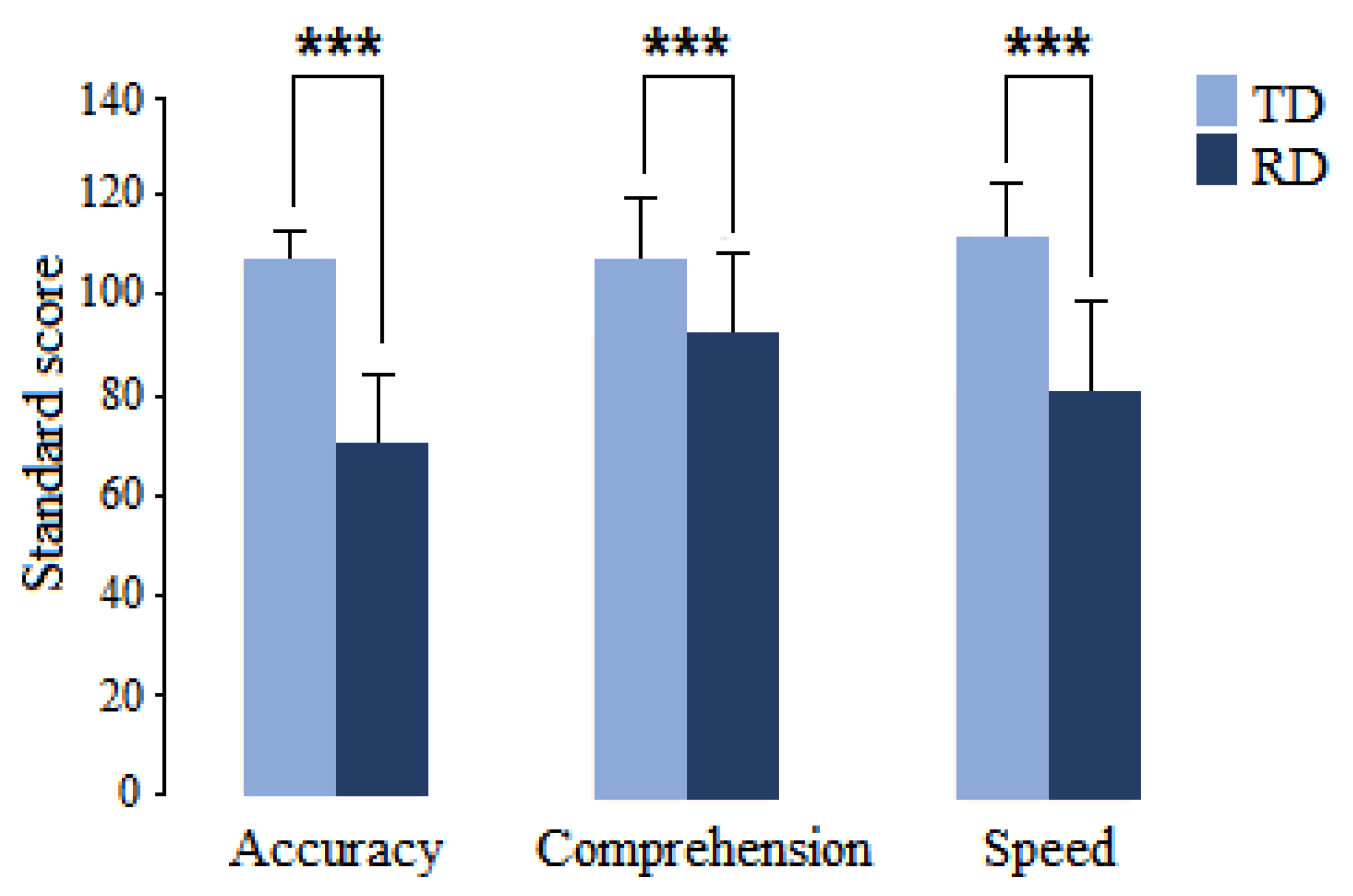
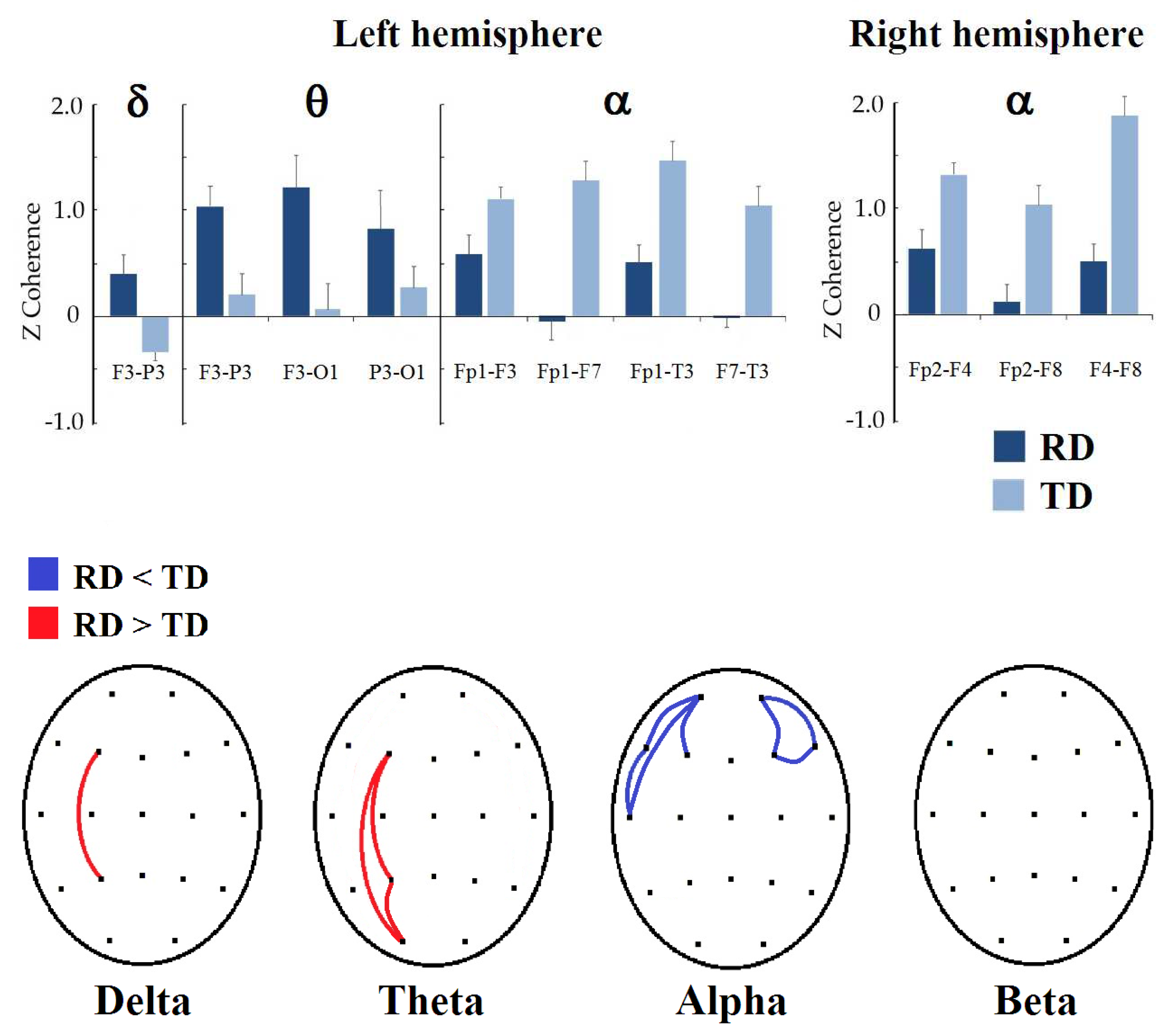
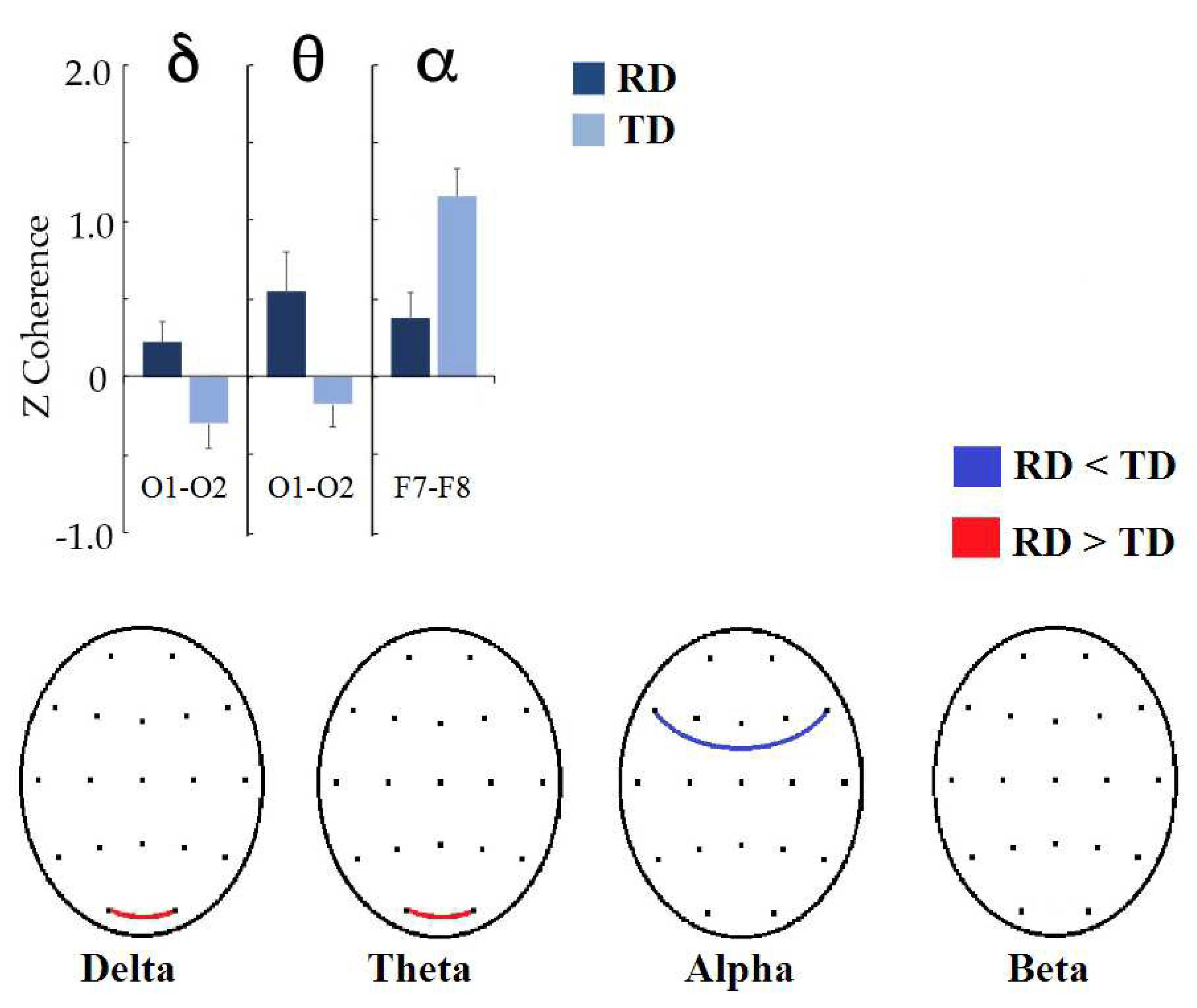
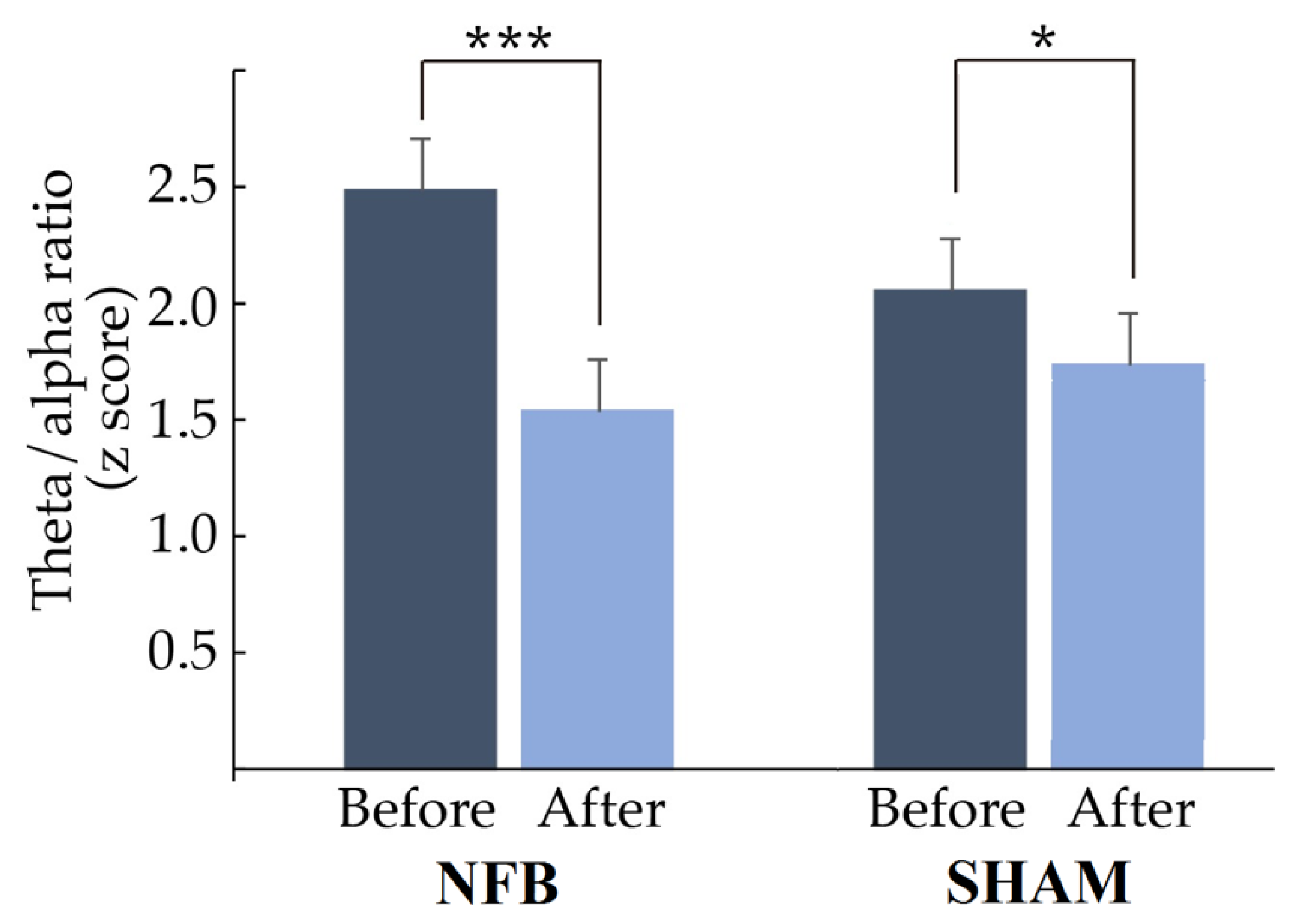
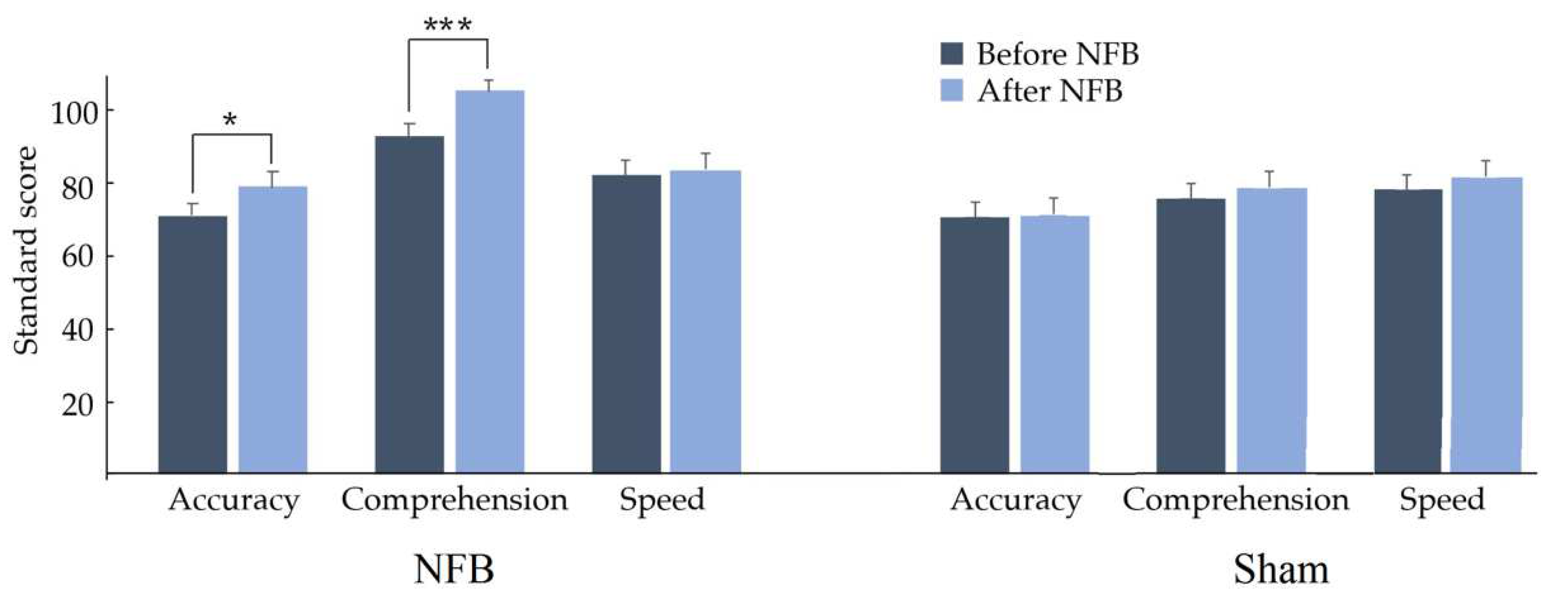
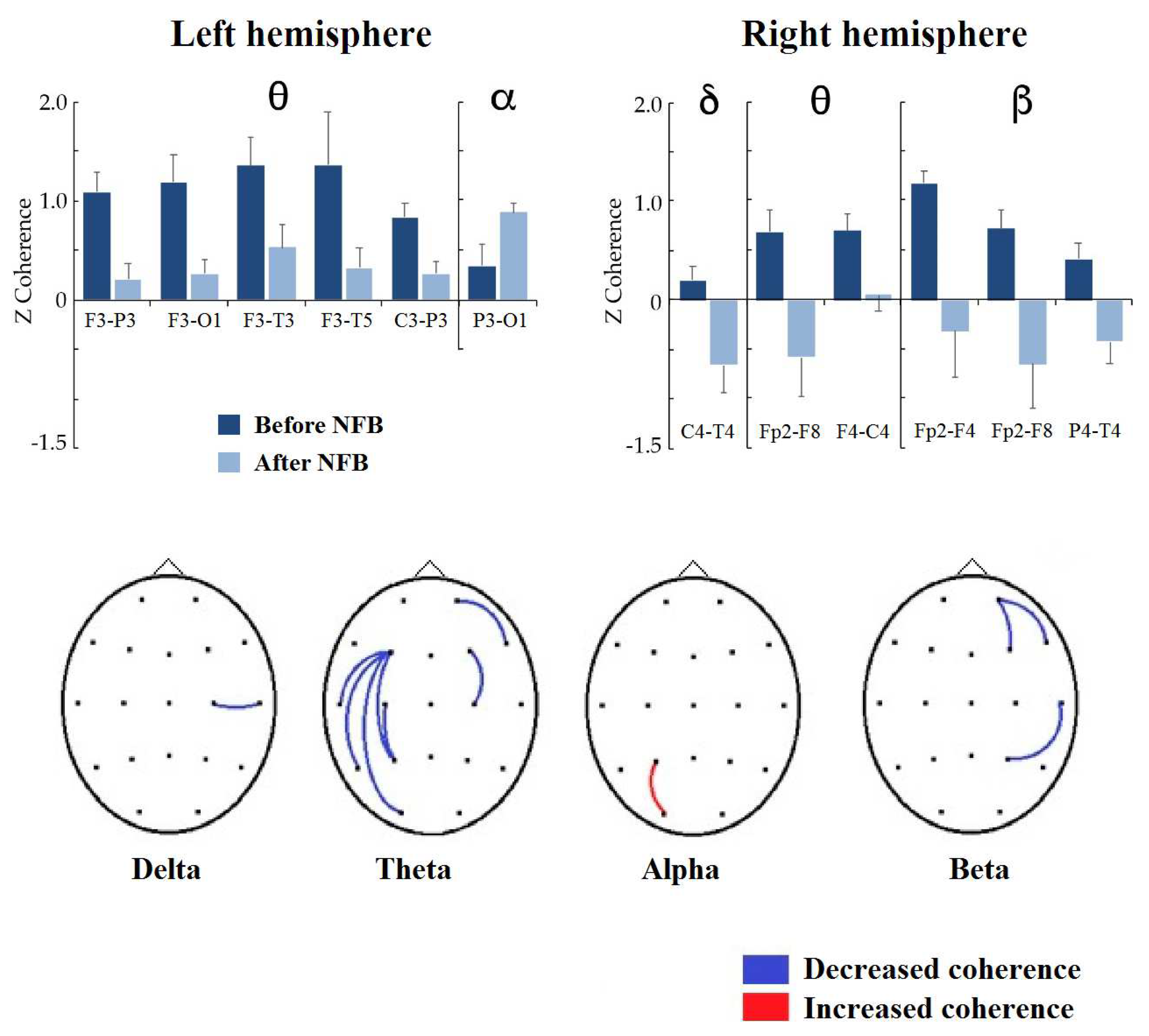

Disclaimer/Publisher’s Note: The statements, opinions and data contained in all publications are solely those of the individual author(s) and contributor(s) and not of MDPI and/or the editor(s). MDPI and/or the editor(s) disclaim responsibility for any injury to people or property resulting from any ideas, methods, instructions or products referred to in the content. |
© 2023 by the authors. Licensee MDPI, Basel, Switzerland. This article is an open access article distributed under the terms and conditions of the Creative Commons Attribution (CC BY) license (https://creativecommons.org/licenses/by/4.0/).
Share and Cite
Albarrán-Cárdenas, L.; Silva-Pereyra, J.; Martínez-Briones, B.J.; Bosch-Bayard, J.; Fernández, T. Neurofeedback Effects on EEG Connectivity among Children with Reading Disorders: I. Coherence. Appl. Sci. 2023, 13, 2825. https://doi.org/10.3390/app13052825
Albarrán-Cárdenas L, Silva-Pereyra J, Martínez-Briones BJ, Bosch-Bayard J, Fernández T. Neurofeedback Effects on EEG Connectivity among Children with Reading Disorders: I. Coherence. Applied Sciences. 2023; 13(5):2825. https://doi.org/10.3390/app13052825
Chicago/Turabian StyleAlbarrán-Cárdenas, Lucero, Juan Silva-Pereyra, Benito Javier Martínez-Briones, Jorge Bosch-Bayard, and Thalía Fernández. 2023. "Neurofeedback Effects on EEG Connectivity among Children with Reading Disorders: I. Coherence" Applied Sciences 13, no. 5: 2825. https://doi.org/10.3390/app13052825
APA StyleAlbarrán-Cárdenas, L., Silva-Pereyra, J., Martínez-Briones, B. J., Bosch-Bayard, J., & Fernández, T. (2023). Neurofeedback Effects on EEG Connectivity among Children with Reading Disorders: I. Coherence. Applied Sciences, 13(5), 2825. https://doi.org/10.3390/app13052825






